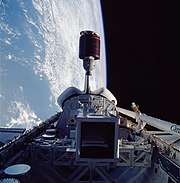Telstar 303
Telstar 303[1] is a U.S. communications satellite launched from Space Shuttle Discovery during STS-51-G on 17 June 1985. Owned by AT&T and operated by Loral Skynet Hughes, it was one of three Telstar 3 satellites, Preceded by Telstar 301 in 1983 and Telstar 302 in 1984.
 Telstar 303 in orbit | |
| Mission type | Communications |
|---|---|
| Operator | AT&T → Loral Skynet |
| COSPAR ID | 1985-048D |
| SATCAT no. | 15826 |
| Mission duration | 10 years |
| Spacecraft properties | |
| Bus | LS-1300 |
| Manufacturer | Hughes |
| Launch mass | 1,140 kilograms (2,510 lb) |
| BOL mass | 653 kilograms (1,440 lb) |
| Start of mission | |
| Launch date | June 17, 1985, 11:33 UTC |
| Rocket | Space Shuttle Discovery |
| Launch site | Kennedy LC-39A |
| Contractor | NASA |
| Orbital parameters | |
| Reference system | Geocentric |
| Regime | Geostationary |
| Eccentricity | 0.00007 |
| Perigee altitude | 35,784 kilometres (22,235 mi) |
| Apogee altitude | 35,790 kilometres (22,240 mi) |
| Inclination | 0° |
| Period | 1,436.1 minutes |
| Epoch | June 17, 1985 |
| Transponders | |
| Band | 24 C band |
| Coverage area | North America, Hawaii, Puerto Rico |
Description
The satellite served as the U.S. west coast and mid-west home satellite (C band) with 48 Transponders for the ABC network from 1984 to 1993. The CBS network used the satellite from 1985 to 1993. It also served as telephone call transfer for remote areas until 1993.
Other entities that used the satellite included Group W, Wold/Keystone Communications (which used the satellite to feed Paramount Television's syndicated output including Entertainment Tonight, Star Trek: The Next Generation, and Star Trek: Deep Space Nine), Compact Video, Lorimar-Telepictures, and Warner Bros. Television.
In 1987, Melvin Rosen and Stuart Levin acquired 17 transponders on Telstar 303 satellite for the purpose of creating the first and largest multi-channel pay-per-view satellite TV system to serve the C-band satellite TV market. ln 1993 as the Satellite was about to retire, a group of business owners including General Instruments, TVN Entertainment, Parallex Data Systems, and Enterprises put together programs systems and home units to bring affordable IPPV (ImpulsePayPerView) and PPV (PayPerView) entertainment to the home. Acquiring Telstar 303 required moving it from 125 to 104 west and a little changing of internal code to extend battery life and accept its new job parameters.
The satellite was retired in 1999 and replaced by Telstar 401.[2] All three of the Telstar 4 series satellite met with disaster and are still in orbit as space junk.[3]
References
- Krebs, Gunter. "dipl.phys". Telstar3. Retrieved 25 March 2016.
- Krebs, Gunter. "dipl.phys". Telstar4. Retrieved 25 March 2016.
- McDowell, Jonathan (Oct 2015). "PhD". Quasars. Harvard. Retrieved 25 March 2016.